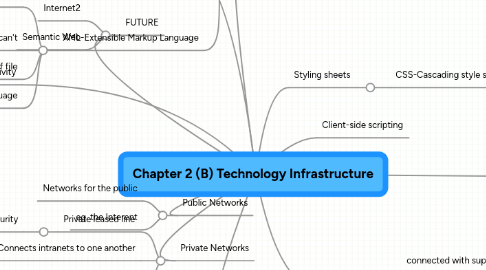
1. Markup Languages
1.1. Tags
1.1.1. Formatting instructions
2. Types of Markup Languages
2.1. SGML-Standard Generalized Markup Language
2.1.1. Independent of software application
2.2. HTML-Hypertext Markup Language
2.2.1. tags
2.2.1.1. Format and style
2.2.1.2. Create relationships-hypertext elements
2.2.2. most commonly used on web today
2.2.3. Linear hyperlink structure
2.2.3.1. eg. pages of a book
2.2.4. Hierarchical hyperlink structure
2.2.4.1. eg. home page...
2.3. XML-Extensible Markup Language
2.3.1. Similar to HTML
2.3.1.1. except for 2 respects
2.3.1.1.1. not a Markup language w/defined tags
2.3.1.1.2. tags don't specify text appearance on the web
2.3.2. Data managment that HTML can't
2.3.3. Purpose of file
2.3.3.1. Child elements
2.3.4. ESL-Extensible Stylesheet Language
2.3.4.1. Java
3. Public Networks
3.1. Networks for the public
3.2. eg. the Interent
4. Private Networks
4.1. Private leased line
4.1.1. gives added security
4.2. Connects intranets to one another
4.3. Costly
4.3.1. scaling problem
5. VPN-Virtual Private network
5.1. Extranet
5.1.1. uses public networks
5.2. IP tunneling
5.2.1. more secure
6. Connectivity
6.1. Bandwidth
6.1.1. Symmetric
6.1.2. Asymmetric
6.1.3. Upstream
6.1.4. Downstream
6.2. Broadbands
6.2.1. ADSL
6.2.2. HDSL
6.3. Cable
6.4. Telephone
6.5. Leased line
6.6. Wireless
6.7. Bluetooth and Ultra Wideband
6.7.1. Wirelss Ethernet (Wi-Fi)
6.7.2. Fixed -Point Wireless
6.7.3. Cellular telephone networks
7. FUTURE
7.1. Internet2
7.2. Semantic Web
8. Client-side scripting
9. Styling sheets
9.1. CSS-Cascading style sheets
10. Intranets
10.1. Intereconnected networks
10.2. low cost way for businesses to distribute internal information
10.3. Protocols
10.3.1. TCP/IP
10.3.2. FTP
10.3.3. Telnet
10.3.4. HTML
10.3.5. HTTP
